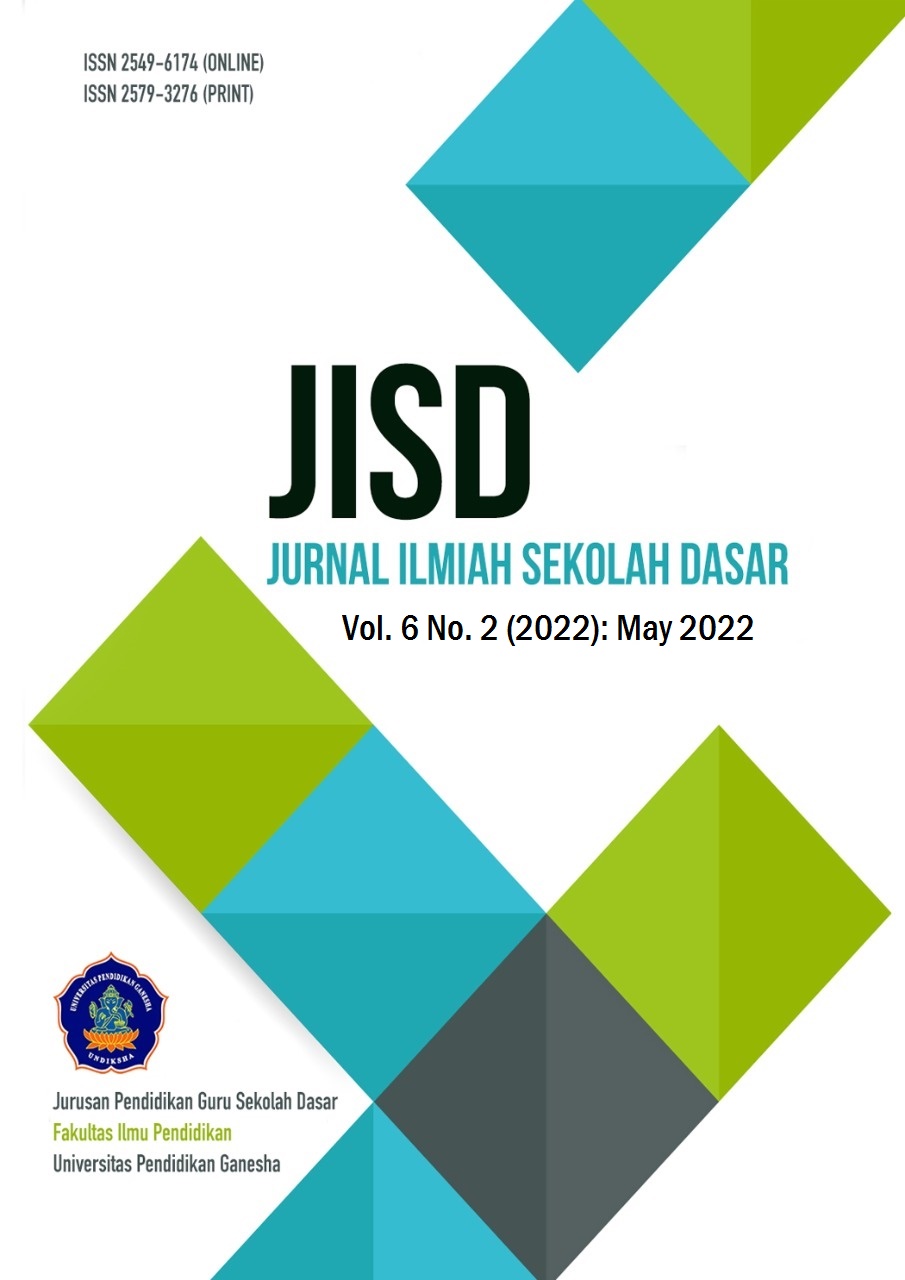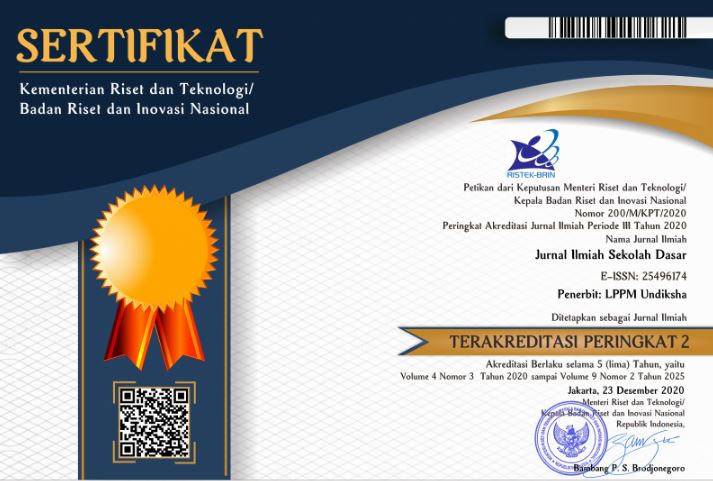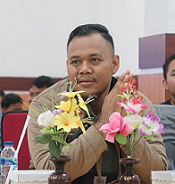ANIMA-LIE: Android-Based Learning Media on Animal Life Cycles Materials for Elementary School
DOI:
https://doi.org/10.23887/jisd.v6i2.45359Keywords:
Learning Media, Mobile Learning, Android, Animal Life CycleAbstract
The learning media used for teachers in online learning during the pandemic are only limited to using pictures, words, sounds, videos, and powerpoints in the form of simple presentations. Thus, the media is not optimal in helping students understand the material and does not increase students' direct experience. It takes the development of online learning media based on android applications to solve these problems. This study aims to develop an android-based learning media "Anima-lie" on animal life cycle material for grade IV elementary school. The research model used is Research and Development (R&D) by applying the ADDIE development model. This application was piloted on 37 fourth grade students. The instrument used is a validation questionnaire for 2 material experts, 2 media experts, and a user response questionnaire. The results of the product developed based on the assessment of material experts get an average score percentage of 85.5% in the good category and for the media expert assessment the average score percentage is 89.93% in the very good category. For the results of student responses, the percentage of the average score is 83.64% with a good category. Based on the data results indicate that the development of the Android-based mobile learning application "Anima-lie" with animal life cycle material is suitable for use as a learning medium for fourth grade elementary school students.
References
Allagui, B. (2014). Writing through WhatsApp: An evaluation of students writing performance. International Journal of Mobile Learning and Organisation, 8(3–4), 216–231. https://doi.org/10.1504/IJMLO.2014.067022. DOI: https://doi.org/10.1504/IJMLO.2014.067022
Amin, F. M., & Sundari, H. (2020). Efl students’ preferences on digital platforms during emergency remote teaching: Video conference, lms, or messenger application? Studies in English Language and Education, 7(2), 362–378. https://doi.org/10.24815/siele.v7i2.16929. DOI: https://doi.org/10.24815/siele.v7i2.16929
Bergvall-Kåreborn, B., & Howcroft, D. (2013). ‘The future’s bright, the future’s mobile’: a study of Apple and Google mobile application developers. Work, Employment and Society., 27(6), 964–981. https://doi.org/10.1177/0950017012474709. DOI: https://doi.org/10.1177/0950017012474709
Damayanthi, A. (2020). Efektivitas Pembelajaran Daring di Masa Pandemi Covid 19 pada Perguruan Tinggi Keagamaan Katolik. JURNAL SOSIAL :Jurnal Penelitian Ilmu-Ilmu Sosial, 21(3), 53–56. https://doi.org/10.17509/e.v1i3.26978. DOI: https://doi.org/10.33319/sos.v21i2.61
Darmawan, D. (2013). Teknologi Pembelajaran. Remaja Rosdakarya.
Dewi, F. F., & Handayani, S. L. (2021). Pengembangan Media Pembelajaran Video Animasi En-Alter Sources Berbasis Aplikasi Powtoon Materi Sumber Energi Alternatif Sekolah Dasar. Jurnal Basicedu, 5(4), 2530–2540. https://doi.org/10.31004/basicedu.v5i4.1229. DOI: https://doi.org/10.31004/basicedu.v5i4.1229
Dwiyanti, G., & Nahadi. (2011). RPP, Pengembangan Indikator, dan Tujuan Pembelajaran. Universitas Pendidikan Indonesia.
Gunawan, A., Harjono, H., Sahidu, L., & Herayanti. (2017). Virtual laboratory to improve students’ problem-solving skills on electricity concept. Jurnal Pendidikan IPA Indonesia, 6(2), 257–264. https://doi.org/10.15294/jpii.v6i1.8750. DOI: https://doi.org/10.15294/jpii.v6i2.9481
Hermawan, S. S. (2011). Mudah Membuat Aplikasi Android. Penerbit Andi.
Indah, I. G. A. K. N., Agung, A. A. G., & Suartama, I. K. (2016). Pengembangan Mobile Learning Dengan Model Dick Dan Carey Pada Mata Pelajaran Biologi Di Smpn 5 Mendoyo. Jurnal Edutech Undiksha, 4(2), 4. https://doi.org/10.23887/jeu.v4i2.7772.
Irsyadi, & Annas, K. (2019). Game Edukasi Pembelajaran Bahasa Inggris untuk Pengenalan Benda-Benda di Rumah bagi Siswa Kelas 4 Sekolah Dasar. JATI, 9(September), 78–92. https://doi.org/10.34010/jati.v9i2. DOI: https://doi.org/10.34010/jati.v9i2.1844
Januszewski, A., & Molenda, M. (2013). Educational technology: A definition with commentary. Taylor and Francis. https://doi.org/10.4324/9780203054000. DOI: https://doi.org/10.4324/9780203054000
Khairunisa, S. D., Amirullah, G., & Ninawati, M. (2019). Pengembangan Media Pembelajaran Aplikasi Mobile Learning Berbasis Android Pada Mata Kuliah Konsep Dasar Ilmu Pengetahuan Alam. Jurnal Inovasi Pendidikan Dasar, 4(2), 49–56. https://doi.org/10.22236/jipd.v4i2.80. DOI: https://doi.org/10.22236/jipd.v4i2.80
Lukman, A., Hayati, D. K., & Hakim, N. (2019). Pengembangan Video Animasi Berbasis Kearifan Lokal pada Pembelajaran IPA Kelas V di Sekolah Dasar. Elementary: Jurnal Ilmiah Pendidikan Dasar, 5(2), 153. https://doi.org/10.32332/elementary.v5i2.1750. DOI: https://doi.org/10.32332/elementary.v5i2.1750
Maiyana, E. (2018). Pemanfaatan android dalam perancangan aplikasi kumpulan doa. Jurnal Sains Dan Informatika: Research of Science and Informatic, 4(1), 54–65. https://doi.org/10.22216/jsi.v4i1.3409. DOI: https://doi.org/10.22216/jsi.v4i1.3409
Ningsih, S., & Adesti, A. (2019). Pengembangan Mobile Learning Berbasis Android pada Mata Kuliah Strategi Pembelajaran Universitas Baturaja. Edcomtech: Jurnal Kajian Teknologi Pendidikan, 4(2), 163–172. https://doi.org/10.17977/um039v4i22019p163.
Pramita, P. A., Sudarma, I. K., & Murda, I. N. (2019). Pengaruh Model Pembelajaran Scramble Berbantuan Media Gambar terhadap Hasil Belajar IPA. Jurnal Pedagogi Dan Pembelajaran, 2(2), 186. https://doi.org/10.23887/jp2.v2i2.17907. DOI: https://doi.org/10.23887/jp2.v2i2.17907
Prawiradilaga, D. S. (2008). Prinsip Desain Pembelajaran. Kencana Perenda Media Group.
Prawiyogi, A. G., Purwanugraha, A., Fakhry, G., & Firmansyah, M. (2020). Efektifitas Pembelajaran Jarak Jauh Terhadap Pembelajaran Siswa di SDIT Cendekia Purwakarta. Jurnal Pendidikan Dasar, 11(01), 94–101. https://doi.org/10.21009/10.21009/JPD.081. DOI: https://doi.org/10.21009/10.21009/JPD.081
Pujiasih, E. (2020). Membangun Generasi Emas Dengan Variasi Pembelajaran Online Di Masa Pandemi Covid-19. Ideguru: Jurnal Karya Ilmiah Guru, 5(1), 42–48. https://doi.org/10.51169/ideguru.v5i1.136. DOI: https://doi.org/10.51169/ideguru.v5i1.136
Putri, R. A., & Handayani, S. L. (2021). Pengambangan Media SiMach Land Berbasis Android di Sekolah Dasar. Jurnal Basicedu, 5(4), 2541–2549. https://doi.org/10.31004/basicedu.v5i4.1230. DOI: https://doi.org/10.31004/basicedu.v5i4.1230
Radifan, M. F., & Dewanti, R. (2020). The Incorporation of 4C Skills in Senior High School English Teachers ’ Lesson Plans. STAIRS English Language Education Journal, 1(1), 42–54. http://journal.unj.ac.id/unj/index.php/stairs/article/view/20940.
Rahmat, R. F., Mursyida, L., Rizal, F., Krismadinata, K., & Yunus, Y. (2019). Pengembangan media pembelajaran berbasis mobile learning pada mata pelajaran simulasi digital. Jurnal Inovasi Teknologi Pendidikan, 6(2), 116–126. https://doi.org/10.21831/jitp.v6i2.27414. DOI: https://doi.org/10.21831/jitp.v6i2.27414
Rajhans, V., Memon, U., Patil, V., & Goyal, A. (2020). Impact of COVID-19 on academic activities and way forward in Indian Optometry. Journal of Optometry, 13(4), 216–226. https://doi.org/10.1016/j.optom.2020.06.002. DOI: https://doi.org/10.1016/j.optom.2020.06.002
Ramdani, A., Jufri, A. W., & Jamaluddin, J. (2020). Pengembangan Media Pembelajaran Berbasis Android pada Masa Pandemi Covid-19 untuk Meningkatkan Literasi Sains Peserta Didik. Jurnal Kependidikan: Jurnal Hasil Penelitian Dan Kajian Kepustakaan Di Bidang Pendidikan, Pengajaran Dan Pembelajaran, 6(3), 433. https://doi.org/10.33394/jk.v6i3.2924. DOI: https://doi.org/10.33394/jk.v6i3.2924
Ratnasari, D. T., & Ginanjar, A. (2020). Pengembangan Komik Digital Sebagai Media Edukasi Penanggulangan Bencana Alam. Naturalistic : Jurnal Kajian Penelitian Pendidikan Dan Pembelajaran, 4(1). https://doi.org/10.35568/naturalistic.v4i1.679. DOI: https://doi.org/10.35568/naturalistic.v4i1.679
Risnawati, ., Amir, Z., Lubis, M. S., Syafri, M., & Andrian, D. (2019). The Effectiveness of Problem Based Learning (PBL) in Increasing Student Creative Thinking and Self-efficacy. Proceedings of the Second International Conference on Social, Economy, Education and Humanity, 152–156. https://doi.org/10.5220/0009096701520156. DOI: https://doi.org/10.5220/0009096701520156
Sahfitri, V. (2019). Prototype E-Katalog Dan Peminjaman Buku Perpustakaan Berbasis Mobile. Jurnal Sisfokom (Sistem Informasi Dan Komputer), 8(2), 165–171. https://doi.org/10.32736/sisfokom.v8i2.665. DOI: https://doi.org/10.32736/sisfokom.v8i2.665
Saleem, T. A. (2011). Mobile Learning Technology: A New Step in E-Learning. Journal of Theoritical and Aplied Information Technology, 34(2), 125–137. http://www.jatit.org/volumes/Vol34No2/4Vol34No2.pdf.
Sanjaya, W. (2013). Strategi Pembelajaran Berorientasi Standar Proses Pendidikan. Kencana.
Sarrab, M., Elgamel Laila, & Al-dabbas, H. (2012). Mobile Learning (M-Learning) and Educational Environment. International Journal of Distributed and Parallel System, 3(4), 31–39. https://www.academia.edu/download/55397266/5ff846b519ba00a8219f50a4730f3f40c10d.pdf.
Setyadi, D. (2017). Pengembangan Mobile Learning Berbasis Android Sebagai Sarana Berlatih Mengerjakan Soal Matematika. Satya Widya, 33(2), 87–92. https://doi.org/10.24246/j.sw.2017.v33.i2.p87-92. DOI: https://doi.org/10.24246/j.sw.2017.v33.i2.p87-92
Siripongdee, K., Tuntiwongwanich, S., & Pimdee, P. (2021). Blended Learning Model with IoT-based by Smartphone. International Journal of Interactive Mobile Technologies, 15(11), 166–182. https://doi.org/10.3991/ijim.v15i11.22441. DOI: https://doi.org/10.3991/ijim.v15i11.22441
Sugiyono. (2017). Metode Penelitian Kuantitatif, Kualitatif, dan R & D. CV Alfabeta.
Tirtayani, L. A., Magta, M., & Lestari, N. G. A. M. Y. L. (2017). Teacher Friendly e-Flashcard: a development of bilingual learning media for young learners. Journal of Education Technology., 1(1), 18–29. https://doi.org/10.23887/jet.v1i1.10080. DOI: https://doi.org/10.23887/jet.v1i1.10080
Utami, Y. S. (2020). Penggunaan Media Gambar Untuk Meningkatkan Hasil Belajar Siswa Dalam Pembelajaran IPA. Jurnal Pendidikan Dan Konseling, 2(1), 104–109. https://doi.org/10.31004/jpdk.v1i2.607. DOI: https://doi.org/10.31004/jpdk.v1i2.607
Widiastika, M. A., Hendracipta, N., & Syachruroji, A. (2020). Pengembangan Media Pembelajaran Mobile Learning Berbasis Android Pada Konsep Sistem Peredaran Darah di Sekolah dasar. Jurnal Basicedu, 5(1), 47–64. https://doi.org/10.31004/basicedu.v5i1.602. DOI: https://doi.org/10.31004/basicedu.v5i1.602
Downloads
Published
How to Cite
Issue
Section
License
Copyright (c) 2022 Sri Lestari Handayani, Island Dahlia

This work is licensed under a Creative Commons Attribution-ShareAlike 4.0 International License.
Authors who publish with the Journal Ilmiah Sekolah Dasar agree to the following terms:
- Authors retain copyright and grant the journal the right of first publication with the work simultaneously licensed under a Creative Commons Attribution License (CC BY-SA 4.0) that allows others to share the work with an acknowledgment of the work's authorship and initial publication in this journal.
- Authors are able to enter into separate, additional contractual arrangements for the non-exclusive distribution of the journal's published version of the work (e.g., post it to an institutional repository or publish it in a book), with an acknowledgment of its initial publication in this journal.
- Authors are permitted and encouraged to post their work online (e.g., in institutional repositories or on their website) prior to and during the submission process, as it can lead to productive exchanges, as well as earlier and greater citation of published work. (See The Effect of Open Access)










